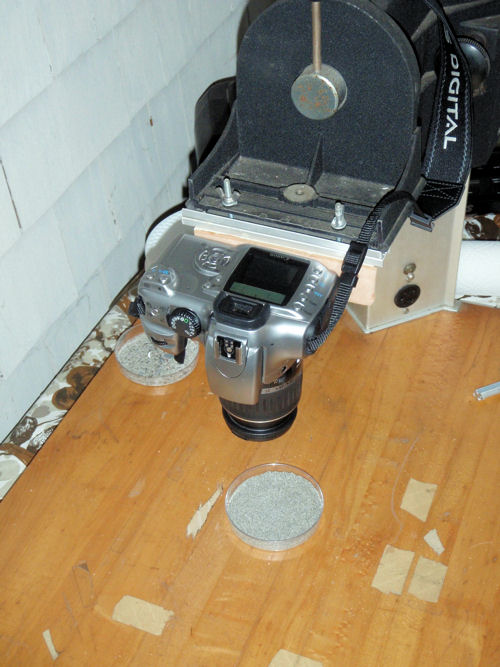

THE ZERO MAGNIFICATION IMAGE
This image tries to show the sand as you would see it as if you had scooped it up, and were holding it in your hand. The area covered by the gross sample is roughly 6cm by 4cm (2.5inches by 1.5 inches) I put a flat layer of sand from Pleasant Bay, Cape Breton in a Petri Dish and shot it from height that just eliminated the Petri Dish. I centered a piece of organic, white material at the center of the image. The white object has a diagonal length of about 4mm.
|
|
|
1 X MACRO IMAGE = 3.6X (*2.2X if full frame image)
I changed lenses, and adjusted the macro lens to the "1X" setting and focused. The big question is what does "1X" actually mean? I opened the gross image in GIMP, and measured the diagonal length of the white feature in pixels. It came out to be 23. I then opened the 1X image in GIMP and made the same measurement. It was 82. I assume that means that the magnification of "1X" is actually 3.6X, so that's what I'm going to call it. I did the same with each of the other images. The red outline on the image on the left shows the actual area covered by the various macro images. Note: In 2014 I changed to a full frame camera. This reduced the magnifications. If the link under the image contains a (*) after the magnification, such as "1X*," use the magnification in the parenthesis.
|
|
|
2X MACRO IMAGE = 6.6X (*4.1X if full frame image)
|
|
|
3X MACRO IMAGE = 9.2X (*5.7X if full frame image)
|
|
|
4X MACRO IMAGE = 12.8X (*7.9X if full frame image)
|
|
|
5X MACRO IMAGE = 16.4X (*10.2X if full frame image)
|
|
|
The macro image is taken with a truly unique macro lens. It is very primitive. You set the magnification and then focus by moving the lens back and forth! At 3X the depth of field is less than 1mm! That means that everything must be in perfect alignment, or some part of the image will be out of focus. The sand must be flat, the camera must be perpendicular to the base. This is a challenge! Originally I tried to do this using a tripod and a table. That was a disaster. Finally, I managed to get an excellent copy stand from a friend, and now the work is relatively simple. All of samples will be photographed at the same magnification from the same height. I've also included a red line scale in each image that shows the scale size of a millimeter. I took a picture of a metric ruler at the same elevation as the sand. The red line is the result. If the grains of sand are too large for a 3X magnification, I'll use something smaller.
|
|
|
Return to Home
|
|